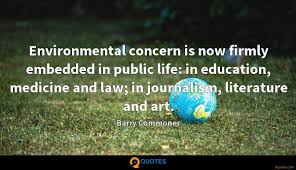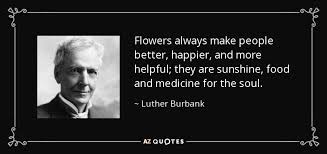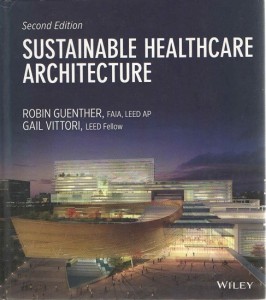Sustainable Healthcare Architecture: A Book
SUSTAINABLE HEALTHCARE ARCHITECTURE
Second Edition
Gail Vittori, LEED Fellow
Chapter 3: Environment and Medicine
“The mirage of modern medicine (to use Rene Dubos’s image) is one facet of the dream of progress as increasing material comfort and mastery over nature, a dream that is drifting into nightmare. The expansionist mindset strives for the gradual and eventual perfect victory over disease, disability, and perhaps even over aging and death. While in this dream state, medicine remains oddly oblivious to the large-scale constraints of ecosystems.”


Jessica Pierce and Andrew Jameton
“Can our present medical industry produce an adequate definition of health? My own guess is that it cannot do so. Like industrial agriculture, industrial medicine has depended increasingly on specialist methodology, medical technology, and chemicals; thus, it’s point of reference has become more and more its own technical prowess and less and less the health of creatures and habitats. I don’t expect this problem to be solved in the universities, which have never addressed, much less solved, the problem of health in agriculture. And I don’t expect it to be solved by the government.”
Wendell Berry (1995)
“The burgeoning number and complexity of known or suspected environmental carcinogens compel us to act to protect public health, even though we may lack irrefutable proof of harm. Action is possible at several levels: conducting scientific research to enhance our understanding and by extension, our ability to prevent and respond to environmental carcinogens; enforcing existing policies and regulations that protect workers and the public; implementing policy and regulatory changes that support public health and reduce the burden of cancer; and taking personal action.”
Source: The President’s Cancer Panel 2009 Annual Report (NCI 2010)
“Natures goods and services are the ultimate foundation of life and health, even though in modern societies this fundamental dependence may be indirect, displaced in space and time, and therefore poorly recognized. This (is) a call to the health sector, not only to cure the diseases that result from environmental degradation, but also to ensure that the benefits that the natural environment provides to human health and well-being are preserved for future generations.”
Lee Jong-Wook, MD, Former Director General, World Health Organization


“We have, over the past decade, seen dramatic growth in the environmental health movement. It has driven the issue of climate change to the top of the global agenda. Awareness of the threat of destruction of the ozone layer resulted in the Montreal Protocol on Substances That Deplete the Ozone Layer in the hopes of reducing the use of the chemicals destroying this fragile layer protecting life on earth. More recently, the Stockholm Convention on Persistent Organic Pollutants became the first global treaty to ban the use of a dozen of the most toxic chemicals. Likewise, efforts to protect and restore the habitats of endangered species have gathered strength around the world, preserving imperiled lands and oceans on an unprecedented scale.”
Michael Lerner, Executive Director, Commonweal (2008)
“Humans cannot have a moral duty to deliver the impossible, or to supply something if the act of supplying it harms the ecosystem to the point where life on earth becomes unsustainable. Moral codes, no matter how logical and well-reasoned, and human rights, no matter how compassionate, must make sense within the limits of the ecosystem; we cannot disregard the factual consequences of our ethics. If acting morally compromises the ecosystem, then moral behavior must be rethought. Ethics cannot demand a level of resource use that the ecosystem cannot tolerate.”
Herschel Elliot and Richard Lamm (2002)
“Imagine a time when going to a hospital is seen as the failure of the health and social care system. Where most of the care and support you need can be offered at home. Where you can get instant medical help online, by phone or at a local health centre. Where health inequalities are low and well-being is key.


Imagine a place where the few buildings that support the health system are in tune with the environment. They use almost no carbon and are integrated into the community and with nature. They are inviting for patients and a pleasure to work in.
Imagine a world where friends, family and society help promote healthy living. Where we all support the local health and social care system to recycle, re-use and minimize waste. Where we know that delivery of services takes the long-term financial, social and environmental costs into account.
Imagine knowing that we have done our best to improve health and minimize our impact on the environment.”
Source: The HHS Route map for Sustainable Health (NHS SDU 2011)
“Climate change could be the biggest global health threat of the 21st century. Effects on health of climate change will be felt by most populations in the next decades and put the lives and well-being of billions of people at increased risk”
-The Lancet (Costello et al. 2009)
“Preventive, precautionary action – action with foresight – aimed at increasing the resilience and well-being of the whole biotic community and having salutary effects on individual community members necessitates an expanded ethical framework. As a practical undertaking in institutions with ecologically framed missions, bioethics will embrace its original intent as a guide toward a science of survival and an aid in securing lives of quality. Instead of focusing solely on individual rights and responsibilities, bioethics adds individual membership in larger ecological communities and their health to it’s frame of reference. Anything less perpetuates a worldview belonging to a story that should no longer be told as the way things are.”
CONCLUSION:
Finding common ground between public health and medicine, and acknowledging the profound health consequences of an environment in distress, provide the ethical groundwork for challenging the healthcare sector’s relationship with the environment, and an imperative to proactively create the conditions for health: moving from a position of “do no harm” to a vision of “health promotion”. Grounded by the concepts of prevention and the precautionary principle, emergent trends reveal that healthcare is beginning to transform its practice and embrace a broader ecological framework.
Chapter 4: Nature and Healing
“We cannot win this battle to save species and environments without forging an emotional bond between ourselves and nature as well – for we will not fight to save what we do not love.”


Stephen Jay Gould
“Through its infinite complexity, nature is an instructive and inspirational influence that can expand the aesthetic horizons of the building arts and confirm the inalienable right of humanity to try to salvage a place on this planet before it’s too late. The mission now in architecture, as in all human endeavours, is to recover those fragile threads of connectedness with nature that have been lost for most of this century.”
James Wines
“The “control of nature” is a phrase conceived in arrogance, born of the Neanderthal age of biology and the convenience of man.”
Rachel Carson
“Effectively incorporating these biophilic design elements in constructed buildings and landscapes to varying degrees and in varying combinations can enhance human health and well-being. This list of biophilic design elements can guide healthcare designers and hospital developers in addressing the inherent human affinity for nature. Yet the effectiveness of the design always depends on the creativity and integrative talent of the development more than on following a prescribed list. A checklist can never assure that even a well-intentioned project will produce a harmonious and beneficial design. Like all great constructions, the whole always remains more than the simple sum of its parts.
Two basic dimensions distinguish biophilic design: the human experience of nature – organic or naturalistic design – and the context where this experience occurs – vernacular or place based design. Both low-environmental and biophilic design must work in complementary relation to achieve a true and lasting sustainability. This broader approach to sustainability seeks to avoid and minimize harmful impacts on the natural environment and human health as well as provide and restore beneficial contact between people and nature in the built environment.”
Kellert and Heerwagen (2008)
“Healing gardens, or therapeutic landscapes, are by definition places of renewal. Therapeutic benefits derive from contact with nature because the spatial experience encourages people to connect with a deeper part of themselves and with their natural surroundings. These deep connections, in turn, renew the spirit and help people find a strength that is a crucial part of healing.


Gardens designed to heal should themselves be in a healthy relationship with their biophysical and cultural contexts. Successful gardens tend to transport people away from the intensity of healthcare through contrasts and distractions. But, in doing so, they may ironically, inadvertently displace nature with generic healing gardens. Tucked into the harsh landscapes of courtyards and hospital rooftops, these gardens can be an oasis, but are at risk of failing by being out of step with the ecology of the ambient landscape.
Taking cues from the history of ecological and sustainable design literature, evidence favors survival based on the diversity of the individual palette (Ndubisi 2002). However, behavioural and landscape preference research suggests that people prefer a more controlled, familiar, or even domestic landscape (Marcus 1997). How can a Disneyesque domesticated landscape impart the healing force of nature honestly and sustainably? Given the constraints and environmental boundaries that are often imposed on outdoor places of respite within today’s built environments of acre, is the designed landscape able to impart the same sense of healing that nature provides?”
Jody Rosenblatt-Naderi and Jerry Smith
Summary of Landscape Design Principles for Healing
-
• Celebrate the rhythm and cycles of nature through design by acknowledging seasonal change, natural patterns, and movement of sun, water, terrain, and natural materials.
• Connect to the sacred dimensions of the subculture and biophysical setting unique to each hospital
community.
• Present seasonal experiences with views of infinity along with contextual celestial movements of the sun,
moon and stars.
• Engage all the senses with plants, wind, water, earth, movement and music.
• Utilize horizontal and vertical dynamics that draw the visitor into the garden and provide visual focus
beyond it.
• Evoke memory and familiarity.
• Contrast with the intensity of the healthcare experience through changing scale, materials (nature over
man-made), microclimate (e.g. fresh air, dew, breeze and sunlight), sound levels (in contrast with the
public address system) and views (e.g. infinity at the micro and macro scale, reflections, from windows).
• Employ ergonometric and spatially comfortable details for patients, visitors, staff.
Suggested Design Methods for Enabling Healing
• Provide places for pause along paths that are comfortable, semi-private, sited in response to micro-
climate, and present natural elements through interesting views, smells, textures, and sounds.
• Provide paths connecting transitional spaces to facilitate chance encounters.
• Maximize the number of paths and intersections to facilitate informal walking circuits, path choice, and
contemplative walking.
• Plants trees along paths, around seating, and within views of windows.
• Increase the variety of social spaces and seating groups.
• Engage the sites natural preconstruction condition to celebrate the genius loci of the hospital location.
• Provide signage and accessibility to the garden for all mobility types.
Suggested Design Methods for Enabling Healing
-
• Provide places for pause along paths that are comfortable, semi-private, sited in response to micro-climate, and present natural elements through interesting views, smells, textures, and sounds.
• Provide paths connecting transitional spaces to facilitate chance encounters.
• Maximize the number of paths and intersections to facilitate informal walking circuits, path choice, and contemplative walking.
• Plants trees along paths, around seating, and within views of windows.
• Increase the variety of social spaces and seating groups.
• Engage the sites natural preconstruction condition to celebrate the genius loci of the hospital location.
• Provide signage and accessibility to the garden for all mobility types.
“Our eyes do not divide us from the world, but unite us with it…Let us abandon the self-mutilation which has been our way and give expression to the potential harmony of man-nature. The world is abundant; we require only a deference born of understanding to fulfil man’s promise. Man is that uniquely conscious creature who can perceive and express. He must become the steward of the biosphere. To do this he must design with nature.”
CONCLUSION:
More than 100 years of the systematic decoupling of nature, healing, and healthcare buildings will not be overcome easily. No longer are sacred natural sites reserved for buildings of healing, thanks to the simultaneous commoditization of health and the landscape; nor are healthcare buildings intentionally sited alongside hot springs, or on promontories with water views that resonate with humans in times of stress – places of strong biophilic content for humans in their greatest hours of need.
The dictates of technology and fear of contamination and infection have eliminated most traces of nature from hospital buildings, particularly in North America: the lack of natural ventilation and operable windows, the dependence on electrical lighting over natural daylight, the deep floor plate building, the rejection of courtyards and other nature-inclusive spaces for patient use. Sustainable healthcare architecture challenges this typology; the projects in this book, at this moment of transformation, demonstrate a renewed partnership between building and nature. The creative re-introduction of healing landscapes can assist in developing and strengthening the biophilic connections to nature and further reconnection to the therapeutic powers of nature.
Sustainable design calls the question of whether buildings that purport to heal and restore people can also be a force to restore the natural surroundings thay are sited within. We see in the projects featured in this book that the disciplines of land planning and landscape design bring coherence to the relationship between healing people and healing the Earth. A healthcare campus offers the quintessential opportunity of a place where people can and should experience a positive, restorative natural setting.
I encourage you to buy and read with attention this excellent book which focuses on the need for healthcare designers to connect with nature at all levels of design and to follow the principles of energy-efficient design so as to reduce our dependence on the burning of fossil fuels, the crying need of our times.
Robin Guenther: Sustainable Design
in Health Care
Why hospitals are making us sick
Blair Sadler & Robin Guenther – European Healthcare Design 2015
Healthy Hospitals
Addressing Climate Change in Healthcare
Settings
GGHH Webinar | Buildings: Green Design and Construction of Hospitals
Gail Vittori, Vice Chair of HPDC Board,
Explains the Importance of HPDC’s Work
Building Sustainable Healthcare | Edward
Booty | TEDxSingapore
Healing spaces – the science of place and well-being: Esther Sternberg at TEDxTucson 2013


0 thoughts on “Sustainable Healthcare Architecture: A Book”